综合农艺管理对夏玉米叶片生长发育及内源激素含量的影响
于宁宁 张吉旺 任佰朝 赵 斌 刘 鹏
研究简报
综合农艺管理对夏玉米叶片生长发育及内源激素含量的影响
于宁宁 张吉旺*任佰朝 赵 斌 刘 鹏
作物生物学国家重点实验室/ 山东农业大学农学院, 山东泰安 271018
叶片可直接反映玉米植株的营养状况, 是光合作用的主要场所, 与干物质积累和产量形成密切相关。本研究以郑单958 (ZD958)为试验材料, 以T1代表农民习惯处理; T2代表在T1的基础上, 增加种植密度, 推迟收获, 降低施肥量, 并优化施肥时期; T3代表在T2的基础上进一步增加种植密度和施肥量; T4代表在T3的基础上, 降低种植密度和施肥量; N代表施氮量处理, 设N0、N1、N2和N3分别为0、129.0、184.5和300.0 kg N hm–2, 研究综合农艺管理对夏玉米叶片生长及内源激素的调控作用。综合农艺管理措施包括优化耕作方式、种植密度、施肥量、施肥时期和收获时间等。结果表明, 施氮量不足导致IAA、ZR和GA3含量降低, ABA含量升高, 叶片SPAD值、叶面积指数(LAI)及比叶重均显著降低; 随施氮量的增加, 叶片IAA、ZR和GA3含量增加, ABA含量降低, LAI、SPAD和干物质积累量均显著增加。综合农艺管理处理可调节叶片内源激素含量, 其中T4处理IAA、ZR和GA3含量较T1处理分别高23.1%、9.8%和14.7%; ABA含量降低12.4%; 叶片LAI适宜, SPAD值增加4.2%, 最终单株干物质积累量增加12.6%。综合农艺管理在降低施氮量, 配合最佳的农艺管理方式下, 可调节内源激素含量, 增加叶片SPAD和比叶重, 有利于单株干物质积累, 这可能是促进夏玉米产量增加的重要原因之一。
综合农艺管理; 叶片内源激素; 比叶重; 叶面积指数; SPAD; 干物质积累
目前, 传统农户种植玉米的密度普遍偏低, 但田间施肥量逐年升高, 玉米产量没有持续提升, 氮肥的过度施用却对土壤和环境带来不同程度的破坏[1]。合理增加种植密度, 改麦套为直播, 精确施肥, 适时晚收等农艺措施将成为提高夏玉米产量和生产效率的关键。叶面积指数和叶绿素含量与叶片的光合能力密切相关[2]。合理的LAI和较高的SPAD值可增加群体对光能的截获, 充分发挥产量潜力,促进干物质积累和提高产量。植物激素在调控植物生长发育中起重要作用。内源激素协调平衡, 可改善叶片结构, 增加叶绿素含量, 提高光能截获率[3-4], 促进干物质积累和籽粒产量形成。施氮可显著影响玉米内源激素的含量。增加施氮量可以增加植株细胞分裂素含量[5-6], 降低叶片内部ABA含量, 促进叶片物质交换与气孔开放[7], 提高叶片LAI和SPAD值, 进而促进光合作用。这可能与充足的氮素供应使细胞分裂素合成关键基因上调表达密切相关[8]。目前, 有大量关于单一栽培管理措施对夏玉米叶片生理特性影响的研究, 但关于综合农艺管理措施对夏玉米叶片生理特性及其内源激素含量变化的研究鲜见报道, 本研究通过大田试验, 明确综合农艺管理对夏玉米叶片内源激素含量的影响, 为夏玉米的高产高效生产提供理论依据。
1 材料与方法
1.1 试验设计
基于2009年起的长期定位试验[9-11], 本试验于2016—2017年在山东省泰安市岱岳区大汶口镇(36°11'N, 117°06'E, 海拔178 m)进行。以郑单958 (ZD958)为试验材料, 设置综合农艺管理(将耕作方式、种植密度、施肥量、施肥时期和收获时间等农艺管理措施进行系统性整合以实现产量和效率的协同提升)和施氮量试验, 随机区组试验设计, 等行距种植, 行距60 cm, 小区面积为240 m2, 每个处理4个重复。综合农艺管理试验中以当地农民的种植管理方式为T1 (农民习惯处理); 在T1的基础上, 增加种植密度, 降低施肥量, 并优化施肥时期, 适时推迟收获为T2 (高产高效处理); 在T2的基础上进一步增加种植密度和施肥量, 进一步延迟收获, 创造高产为T3 (超高产处理); 在T3的基础上, 降低种植密度和施肥量, 进一步优化施肥时期为T4(优化综合农艺管理处理)。具体的栽培管理方式见表1。同时设置0、129、184.5和300 kg N hm–2的4个施氮量试验, 分别记为N0、N1、N2和N3(根据玉米生产的最佳施氮量设置N2处理, 在N2的基础上减氮30%为N1, 过量施氮为N3, 以及不施氮对照为N0), 栽培管理方式和磷钾肥的施用量及时期同T4。氮肥为尿素(含氮 46%), 磷肥为过磷酸钙(含P2O517%), 钾肥为氯化钾(含K2O 60%)。各处理同一时间等量灌水。
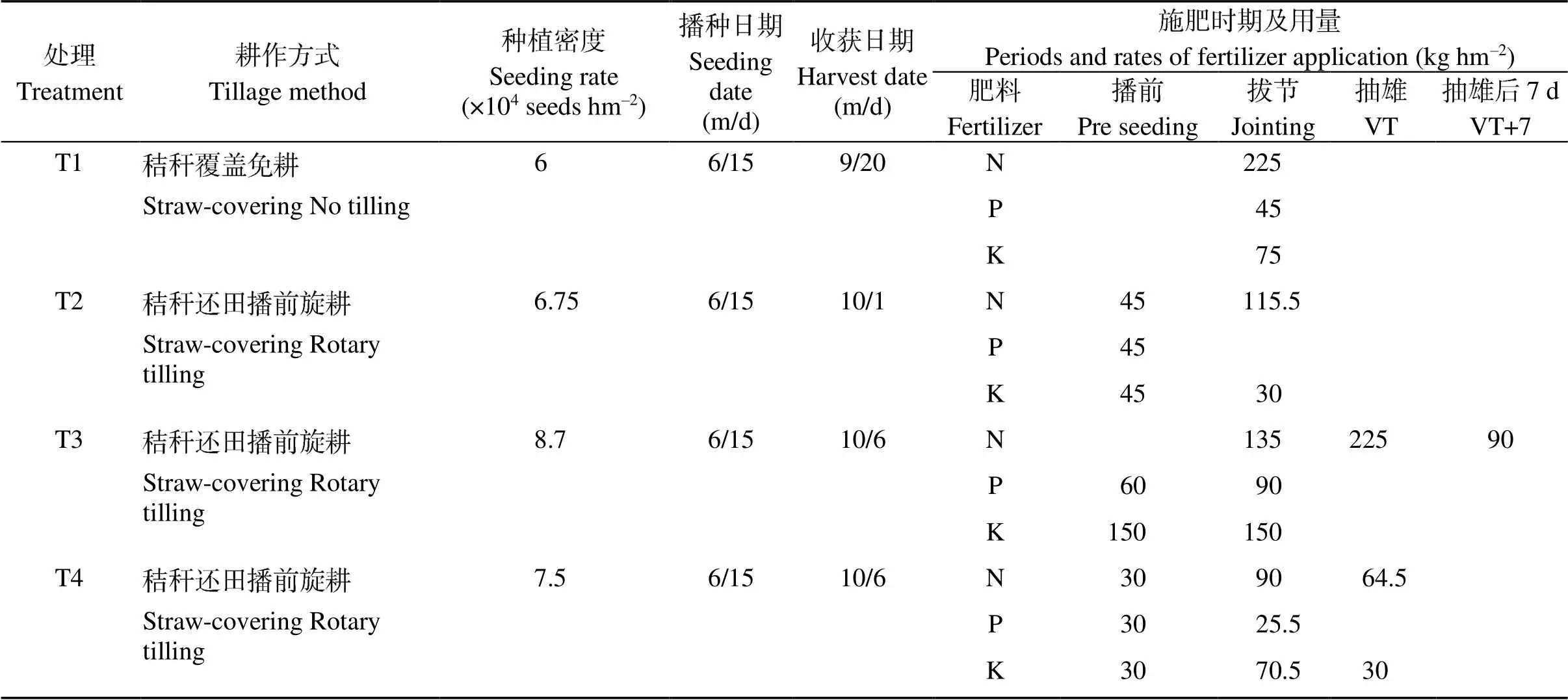
表1 不同处理的栽培管理措施和肥料运筹
播前T3基施30 kg hm–2的ZnSO4。VT: 抽雄期。T1、T2、T3和T4分别代表农民习惯处理、高产高效处理、超高产处理和再高产高效处理。
Before sowing, T3 was applied with 30 kg hm–2ZnSO4. VT: tassel stage. T1, T2, T3, and T4 represent local conventional cultivation, an optimized combination of cropping system and fertilizer treatment, treatment based on high-yield studies, and further optimized combination of cropping system and fertilizer treatment, respectively. m/d: month/day.
1.2 测定项目及方法
1.2.1 干物质积累量 分别于拔节期(V6)、大喇叭口期(V12)、抽雄期(VT)和乳熟期(R3)取有代表性的植株5株, 置烘箱内110℃杀青30 min后80℃烘干至恒量, 称重。
1.2.2 叶面积指数(LAI) 分别于V6、V12、VT、R3和R6 (成熟期)选择有代表性的植株, 每处理选10株, 测量每片玉米叶的长度和最大叶宽值。
单叶叶面积(cm2) = 叶长(cm) × 叶宽(cm) × 0.75
LAI = (单株叶面积× 每个小区的植株数)/小区面积
1.2.3 功能叶片叶绿素含量 使用SPAD-502便携式叶绿素仪(Soil-plant Analysis Development Section, Minolta Camera Co., Osaka, Japan)测定叶绿素相对含量值(SPAD)。分别于V6、V12、VT、R3和R6选取10株生长一致的植株, 避开叶脉, 在上午9:00—12:00测定SPAD值(V6和V12测定最新完全展开叶, VT、R3和R6测穗位叶)。
1.2.4 叶片激素含量 分别于V4 (四叶期)、V6、V9 (小喇叭口期)和V12取最新完全展开叶, 于VT和R3取穗位叶, 液氮速冻后置−40℃冰箱保存。用酶联免疫法测定ZR、IAA、GA3和ABA含量[12], 酶联免疫试剂盒由中国农业大学提供, 使用Bio-TEK Elx-800 全自动酶标仪测定激素含量。
1.3 数据分析
采用SigmaPlot 10.0、CurveExpert 1.3进行数据处理、作图, 采用SPSS 17.0软件进行数据统计和分析。
2 结果与分析
2.1 LAI和SPAD
如图1所示, 随施氮量的增加, 夏玉米植株的LAI值显著升高。VT时, N2较N0处理的LAI增加了22.5%, N2和N3处理之间无显著差异。综合农艺管理可显著提高夏玉米的叶面积指数, 总体趋势为T3>T4>T2>T1。以VT为例, T2、T3和T4处理的LAI值分别比T1高9.4%、36.9%和19.9%。
夏玉米功能叶片SPAD值, 呈单峰曲线变化, VT时最高(图1)。SPAD随施氮量的增加逐渐增加, N2和N3处理间无显著性差异; N1、N2和N3处理的SPAD值较N0处理分别增加9.9%、14.9%和12.9%。综合农艺管理处理的SPAD在V12到VT之间差异不大; V6时期T2、T3和T4处理分别比T1高3.5%、6.7%和2.7%; R3时期T2、T3和T4处理分别比T1高6.7%、4.7%和4.2%; R6时期T2、T3和T4处理分别比T1高5.5%、23.5%和5.3%。
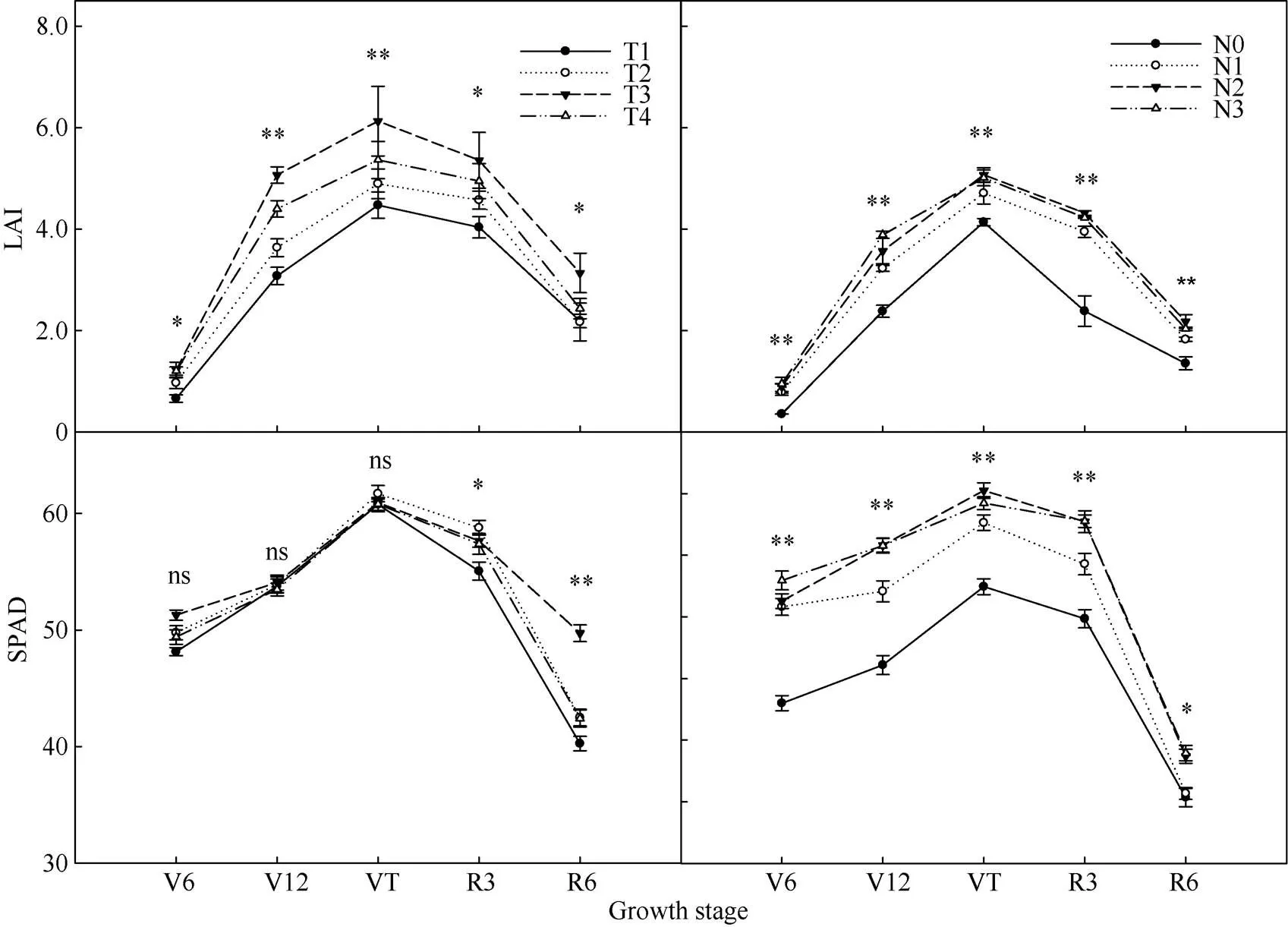
图1 综合农艺管理对夏玉米LAI和SPAD的影响(2017)
T1、T2、T3和T4分别代表农民习惯处理、高产高效处理、超高产处理和再高产高效处理。N0、N1、N2和N3分别表示施0、129.0、184.5和300.0 kg N hm–2。V6、V12、VT、R3和R6分别为玉米拔节期、大喇叭口期、抽雄期、乳熟期和成熟期, 大约分别为播种后21、39、50、80和110 d。*和**分别表示在0.05和0.01水平上差异显著, ns表示处理之间差异不显著。
T1, T2, T3 and T4 are local conventional cultivation, an optimized combination of cropping system and fertilizer treatment, treatment based on high-yield studies, and further optimized combination of cropping system and fertilizer treatment, respectively. N0, N1, N2, and N3 are 0, 129.0, 184.5, and 300.0 kg N hm–2, respectively. V6, V12, VT, R3, and R6 are jointing stage, loudspeaker mouth period, tasseling stage, milking stage and maturation stage of summer maize, which are about 21, 39, 50, 80, and 110 days after sowing, respectively.*and**: significantly different at< 0.05 and< 0.01, respectively, ns: not significant.
2.2 干物质积累和比叶重
由图2可知, 随施氮量的增加, 夏玉米的单株干物质积累呈先增加后降低的趋势, 2年趋势一致, 其中收获时N2处理的单株干物质积累量较N0处理平均显著增加36.7%。综合农艺管理可显著提高夏玉米的干物质积累, T2、T3和T4处理分别较T1处理平均增加12.3%、9.7%和12.6%。
随施氮量的增加, 夏玉米比叶重显著增加。以VT为例, N1、N2和N3处理的比叶重分别比N0高9.8%、24.5%和29.4%。综合农艺管理可显著提高夏玉米的比叶重(表2)。VT时期T2、T3和T4处理的比叶重分别比T1高23.9%、21.5%和23.9%。抽雄后15 d, T2、T3和T4处理分别比T1高19.6%、15.6%和16.3%。R3时期T2、T3和T4处理分别比T1高15.0%、17.1%和6.4%。
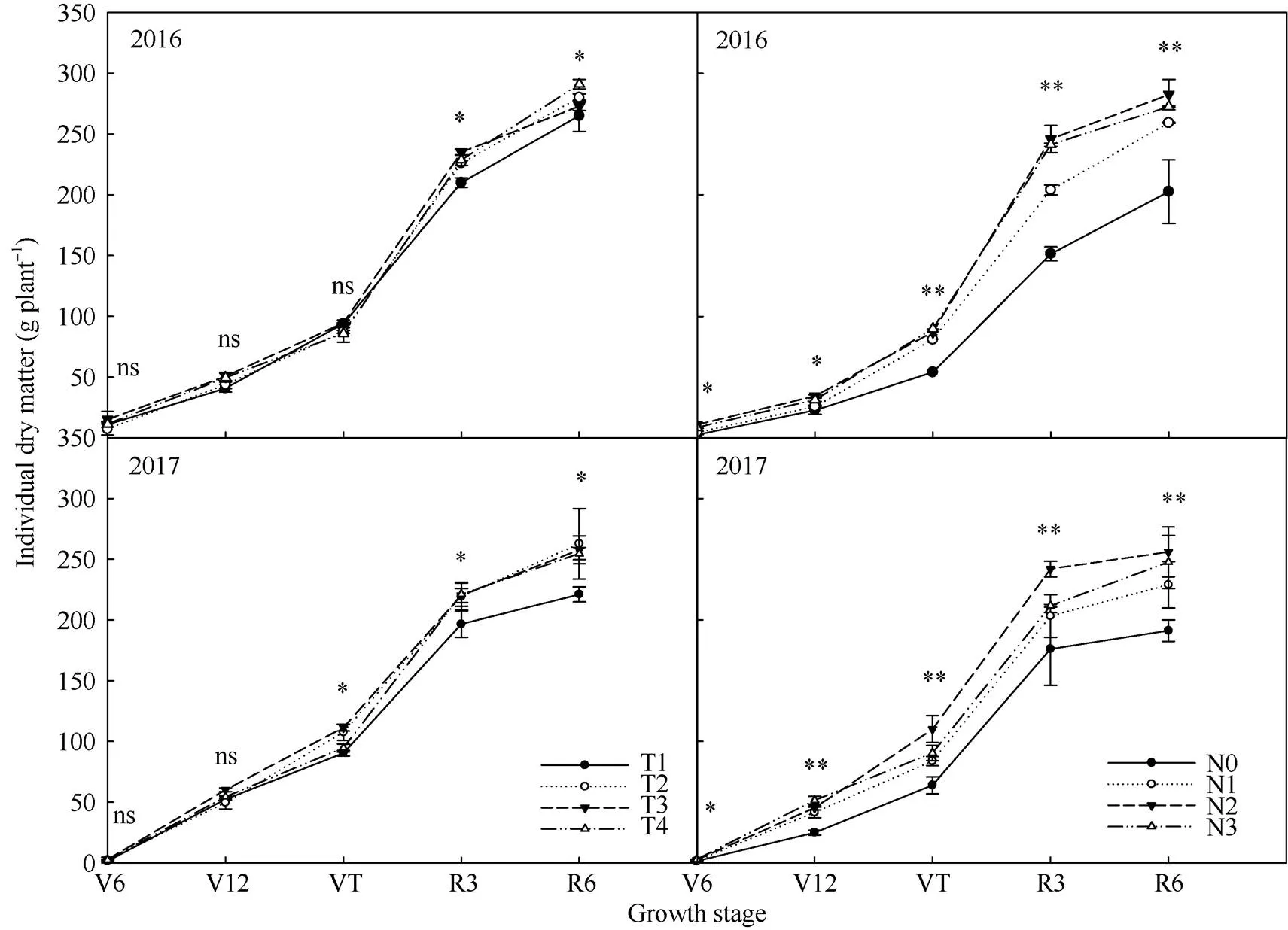
图2 综合农艺管理对夏玉米单株干物质积累的影响(2016–2017)
缩写和处理同图1。*和**分别表示在0.05和0.01水平上差异显著, ns表示处理之间差异不显著。
The abbreviations and treatments are the same as those given in Fig. 1.*and**: significantly different at< 0.05 and< 0.01, respectively, ns: not significant.

表2 综合农艺管理对夏玉米比叶重的影响(2017)
缩写和处理同图1。VT+15代表玉米抽雄后15 d。列内数值后的不同字母表示差异显著(< 0.05)。
The abbreviations and treatments are the same as those given in Fig. 1. VT+15 is 15 days after tasseling stage. Values within a column followed by different letters are significantly different at< 0.05.
2.3 叶片内源激素含量变化
2.3.1 IAA 由图3可知, 叶片中IAA的含量从V4到VT逐渐降低, VT后略有升高, 各处理趋势一致。随施氮量的增加, 叶片中IAA呈先升高后降低的趋势, N1、N2和N3分别较N0处理增加了14.8%、29.7%和25.8%; N3较N2处理降低了2.9%。综合农艺管理显著影响夏玉米叶片IAA含量, 整体趋势表现为T4>T2>T3>T1。T2、T3和T4处理的IAA总量分别较T1处理升高了17.7%、9.3%和23.1%。
2.3.2 ZR 在夏玉米的生长发育过程中, 叶片中ZR的含量从V4到V12逐渐降低, 到VT略有升高后又降低, 各处理趋势一致(图4)。随施氮量的增加, 叶片中ZR的含量先增加后降低。综合农艺管理对叶片中ZR的含量影响显著, 其中T4处理的ZR总量最高, 较T1处理升高了9.8%; T2和T3处理较T1处理升高了5.6%和3.3%。

图3 综合农艺管理对夏玉米叶片IAA含量的影响(2017)
V4和V9为玉米四叶期和九叶期, 为播种后16 d和29 d。缩写和处理同图1。**表示在0.01水平上差异显著。
V4 and V9 are the fourth leaf stage and ninth leaf stage of summer maize, which are about 16 and 29 days after sowing. The abbreviations and treatments are the same as those given in Fig. 1. **: significantly different at< 0.01.
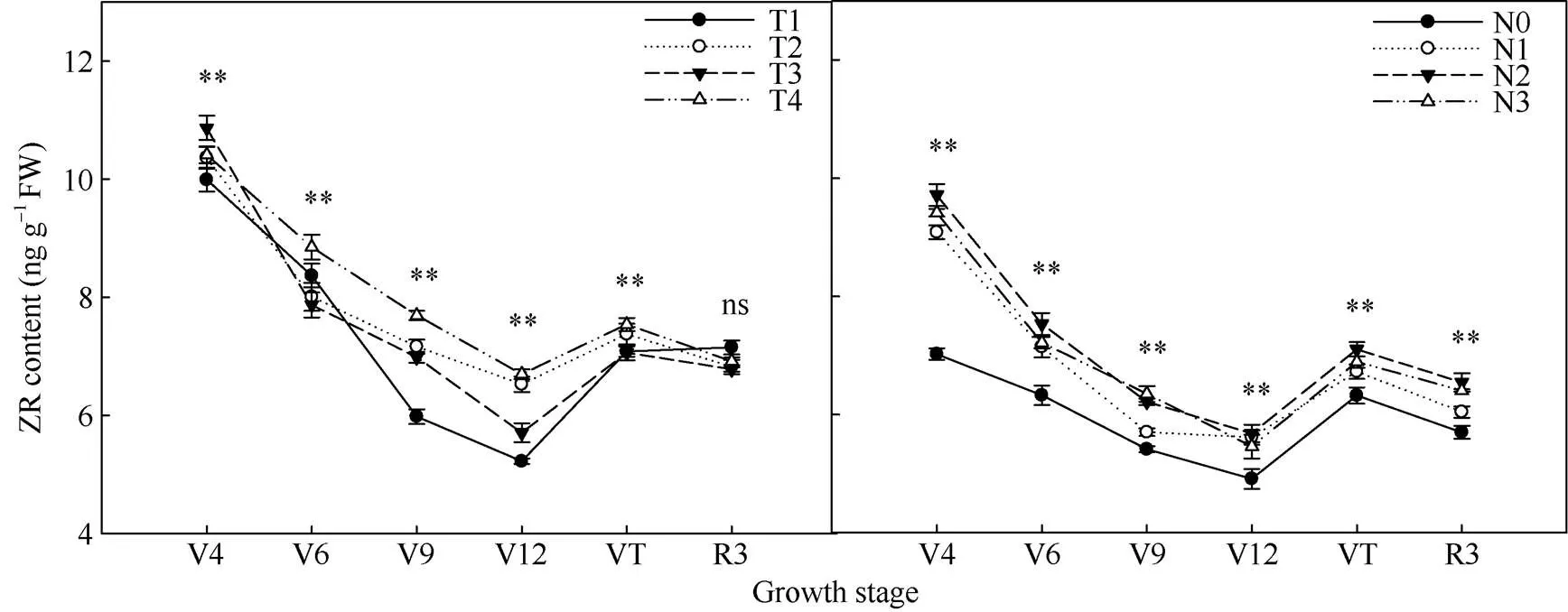
图4 综合农艺管理对夏玉米叶片ZR含量的影响(2017)
缩写和处理同图1和图3。**表示在0.01水平上差异显著, ns表示处理之间差异不显著。
The abbreviations and treatments are the same as those given in Fig. 1 and Fig. 3.**: significantly different at< 0.01; ns: not significant.
2.3.3 GA3在夏玉米的生长发育过程中, 叶片中GA3的含量呈“M”型变化(图5)。不同施氮量处理的GA3总量随施氮量的增加呈先增后降的趋势, N1、N2和N3处理较N0处理分别增加了17.7%、32.7%和25.9%。综合农艺管理能显著提高叶片中GA3的含量, 总体趋势表现为T4>T2>T3>T1。T2、T3和T4处理的GA3总量分别较T1处理升高了11.2%、4.1%和14.7%。
2.3.4 ABA 由图6可知, 叶片中的ABA含量在夏玉米V4到V12期间逐渐降低, 后逐渐升高, 各处理趋势一致。增施氮肥后, 叶片中ABA总量降低, 其中N2处理最低, 较N0降低15.3%; N1和N3处理分别降低了7.9%和10.9%。综合农艺管理可显著降低叶片中ABA含量。T2、T3和T4处理的ABA总量分别较T1处理降低了4.7%、5.1%和12.4%。

图5 综合农艺管理对夏玉米叶片GA3含量的影响(2017)
缩写和处理同图1和图3。**表示在0.01水平上差异显著, ns表示处理之间差异不显著。
The abbreviations and treatments are the same as those given in Fig. 1 and Fig. 3.**: significantly different at< 0.01, ns: not significant.
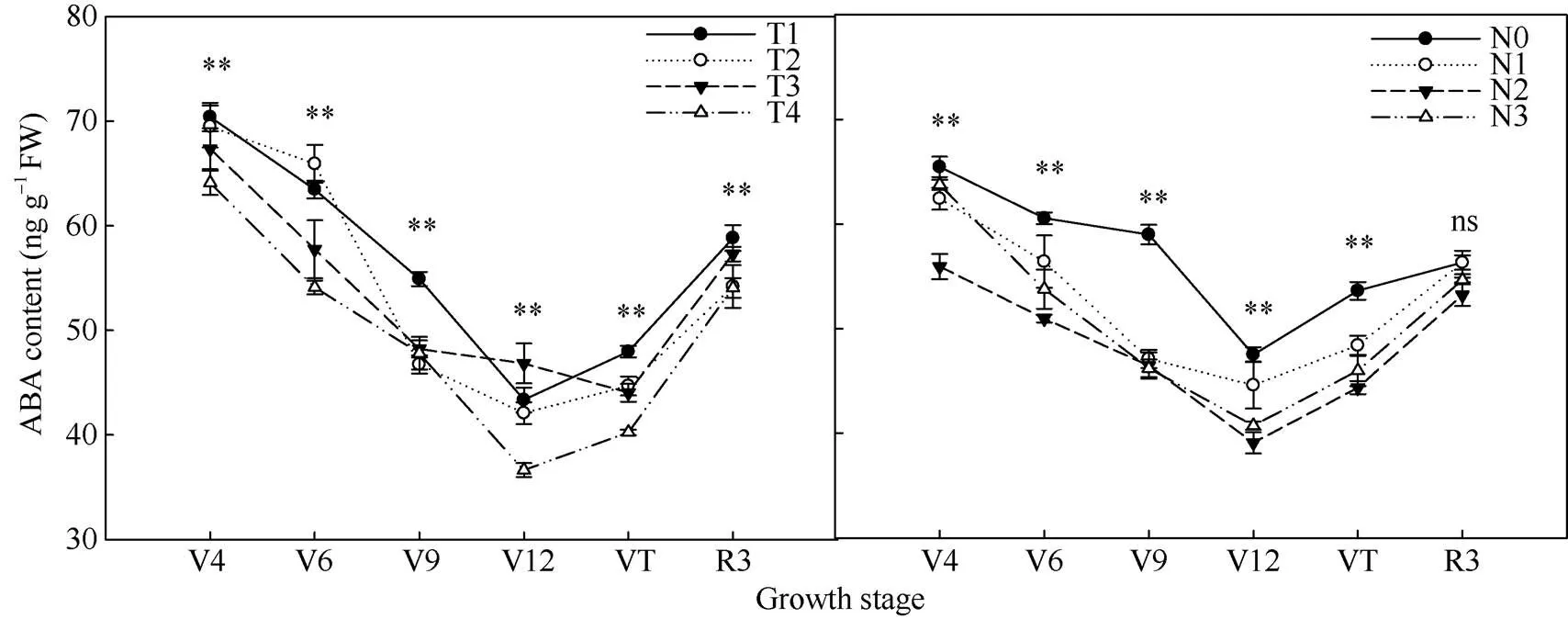
图6 综合农艺管理对夏玉米叶片ABA含量的影响(2017)
缩写和处理同图1和图3。**表示在0.01水平上差异显著, ns表示处理之间差异不显著。
The abbreviations and treatments are the same as those given in Fig. 1 and Fig. 3.**: significantly different at< 0.01, ns: not significant.
2.4 相关性分析
由表3可知, 产量与叶面积指数和单株干物质重呈显著正相关, 相关系数分别为0.764和0.841。叶片LAI和SPAD值与IAA和ABA含量呈显著负相关, 与ZR/ABA、GA3/IAA和ZR/IAA呈显著正相关。单株干物质重与IAA含量呈显著负相关, 与GA3/IAA、ZR/IAA和ABA/(GA3+ IAA+ZR)呈显著正相关。
3 讨论
叶面积指数可以反映作物植株的营养状况及潜在光合能力, 且在生育后期维持较高的LAI有助于干物质的积累和产量的提高[13-14]。籽粒灌浆期间, 较高的叶面积指数对最终干物质积累和产量有重要的作用。大量研究表明, 种植密度过低, 会增加漏光损失; 但种植密度过高会导致群体郁闭, 相互遮阴[15-16]。施肥量和施肥时期不合理, 会导致夏玉米生育后期的叶面积指数迅速下降, 影响群体光合, 进而减少干物质积累[17]。SPAD值是叶片叶绿素含量的相对值[18]。有研究表明, 施氮水平不会影响叶片的SPAD[19], 但也有研究表明, 随施氮量的增加, 叶片SPAD值呈先增加后平稳的趋势[20]或随施氮量的增加呈上升趋势[21]。本研究表明, 随施氮量的增加, LAI和SPAD值均呈先增加后平稳的趋势。前期研究结果表明, 施氮量不足会导致叶肉细胞叶绿体超微结构变劣[17], 这是其叶片SPAD下降的重要原因。综合农艺管理可显著提高夏玉米的LAI和SPAD值。T2、T3和T4处理LAI的增加一部分得益于种植密度的增加; 而T3处理在夏玉米生长后期LAI值迅速下降, 主要是由于种植密度过高, 前期过高的叶面积指数导致群体郁闭, 使下部叶片早衰。T1处理叶片SPAD值在生育后期下降较快, 主要是肥料的一次性施入, 后期脱肥导致的。

表3 叶片性状、单株干物质重和产量与内源激素含量的相关系数
表中数据后**和*分别表示相关性达0.01和0.05显著水平。
**and*indicate significant correlation at< 0.05 and< 0.01, respectively.
种植密度、施肥量和施肥时期等农艺管理措施均会影响夏玉米的干物质积累。增加玉米的种植密度, 在一定范围内光能截获率提高, 光温资源利用率增加, 光合产物积累量增加; 但是若超过玉米品种的适宜种植密度, 将导致中下部叶层叶片早衰, 群体光合能力下降, 干物质积累降低[22-23]。降低施氮量会造成养分供应不足, 植株早衰; 过量施氮会导致作物徒长, 贪青晚熟, 营养器官干物质转运率降低。同时, 追氮和氮肥后移增加干物质最大增长速率, 但延后了干物质最大增长速率出现的天数[24]。本研究表明, 随施氮量的增加, 夏玉米的单株干物质积累先增加后降低, 过量施氮不利于夏玉米干物质的积累, 而过量施氮叶片的比叶重增加可能是由于植株贪青晚熟, 营养物质向籽粒转运的效率下降, 这可能是导致产量下降的重要原因。综合农艺管理可显著提高夏玉米的干物质积累, 但T3处理种植密度过高, 导致单株干物质的积累量较T2和T4处理降低。T1处理肥料一次性施入, 导致生育后期脱肥, 更低的干物质积累量限制其产量的形成。T4处理生育后期比叶重下降迅速, 说明叶片中的营养成分快速向籽粒转运, 有利于产量的形成。
植物激素在调控植物生长发育中起着重要作用。氮素供应影响内源激素的合成代谢, 施氮可明显降低叶片ABA 的含量, 促进细胞分裂素合成, 增大叶片的气孔导度, 提高净光合速率, 增强硝酸还原酶活性, 提高叶片氮素同化能力[25-28]。增施氮、钾肥料可提高叶片CTK含量, 降低ABA含量, 从而增加叶片叶绿素含量, 延缓叶片衰老[29]。养分供应不足将导致植物叶片细胞分裂素含量降低, ABA含量增加, 加速植物衰老[29-30]。本研究表明, 叶片的生长发育需要多种激素协同作用, 且与干物质积累和产量形成密切相关。IAA、ZR和GA3的含量均随施氮量的增加呈现先升高后降低的趋势; 且增施氮肥后ABA含量降低。不施氮, 叶片中IAA、ZR和GA3的含量显著降低, ABA含量显著升高, 这可能破坏了叶片叶绿体光合结构, 导致叶片SPAD值降低, 影响干物质积累和产量形成。综合农艺管理可增加叶片中IAA、ZR和GA3含量, 降低ABA含量, 其中T4处理IAA、ZR和GA3含量最高, ABA 含量最低, 这可能是T4处理叶片的SPAD值增加, 光合特性改善, 促进植株干物质积累和产量形成的重要原因。
[1] Chen X P, Cui Z L, Fan M S, Peter V, Zhao M, Ma W Q, Wang Z L, Zhang W J, Yan X Y, Yang J C, Deng X P, Gao Q, Zhang Q, Guo S W, Ren J, Li S Q, Ye Y L, Wang Z H, Huang J L, Tang Q Y, Sun Y X, Peng X L, Zhang J W, He M R, Zhu Y J, Xue J Q, Wang G L, Wu L, An N, Wu L Q, Ma L, Zhang W F, Zhang F S. Producing more grain with lower environmental costs., 2014, 514: 486–489.
[2] 张子山, 杨程, 高辉远, 李耕, 刘鹏. 保绿玉米与早衰玉米叶片衰老过程中叶绿素降解与光合作用光化学活性的关系. 中国农业科学, 2012, 45: 4794−4800. Zhang Z S, Yang C, Gao H Y, Li G, Liu P. Relationship between photochemistry activity and decrease in chlorophyll content during senescence in leaves of stay green and quick-leaf-senescence inbred line of maize., 2012, 45: 4794–4800 (in Chinese with English abstract).
[3] Wang Y Y, Zhou R, Zhou X. Endogenous levels of ABA and cytokinins and their relation to stomatal behavior in dayflower (L.)., 1994, 144: 145−148.
[4] 张志刚, 尚庆茂. 低温、弱光及盐胁迫下辣椒叶片的光合特性. 中国农业科学, 2010, 43: 123−131. Zhang Z G, Shang Q M. Photosynthetic characteristics of pepper leaves under low temperature, weak light and salt stress., 2010, 43: 123−131 (in Chinese with English abstract).
[5] Wang X, Below F E. Cytokinins in enhanced growth and tillering of wheat induced by mixed nitrogen source., 1996, 36: 121−126.
[6] Chen J G, Cheng S H, Cao W X, Zhou X. Involvement of endogenous plant hormones in the effect of mixed nitrogen source on growth and tillering of wheat., 1998, 21: 87−97.
[7] Radin J W, Ackerson R C. Water relation of cotton plants under nitrogen deficiency: III. Stomatal conductance, photosynthesis and ABA accumulation during drought., 1984, 67: 115−119.
[8] Sakakibara H, Takei K, Hirose N. Interactions between nitrogen and cytokinin in the regulation of metabolism and development., 2006, 11: 440−448.
[9] Jin L B, Cui H Y, Li B, Zhang J W, Dong S T, Liu P. Effects of integrated agronomic management practices on yield and nitrogen efficiency of summer maize in North China., 2012, 134: 30–35.
[10] 朱昆仑, 靳立斌, 董树亭, 赵斌, 刘鹏, 张吉旺. 综合农艺管理对夏玉米叶片衰老特性的影响. 中国农业科学, 2014, 47: 2949–2959. Zhu K L, Jin L B, Dong S T, Zhao B, Liu P, Zhang J W. Effects of integrated agronomic practices on leaf senescence physiological characteristics of summer maize., 2014, 47: 2949–2959 (in Chinese with English abstract).
[11] 靳立斌, 崔海岩, 李波, 杨今胜, 董树亭, 赵斌, 刘鹏, 张吉旺. 综合农艺管理对夏玉米氮效率和土壤硝态氮的影响. 作物学报, 2013, 39: 2009–2015. Jin L B, Cui H Y, Li B, Zhang J W, Dong S T, Zhao B, Liu P, Zhang J W. Effects of integrated agronomic practices on nitrogen efficiency and soil nitrate nitrogen of summer maize., 2013, 39: 2009–2015 (in Chinese with English abstract).
[12] Liu Y, Ding Y F, Wang Q S, Meng D, Wang S. Effects of nitrogen and 6-benzylaminopurine on rice tiller bud growth and changes in endogenous hormones and nitrogen., 2011, 51: 786–792.
[13] Gitelson A, Peng Y, Arkebauer T, Schepers J. Relationships between gross primary production, green LAI, and canopy chlorophyll content in maize: Implications for remote sensing of primary production., 2014, 144: 65–72.
[14] Sade N, Umnajkitikorn K, Rubio M, Wright M, Wang S, Blumwald E. Delaying chloroplast turnover increases water-deficit stress tolerance through the enhancement of nitrogen assimilation in rice., 2017, 69: 867−878.
[15] 陈传永, 侯海鹏, 李强, 朱平, 张振勇, 董志强, 赵明. 种植密度对不同玉米品种叶片光合特性与碳、氮变化的影响. 作物学报, 2010, 36: 871–878. Chen C Y, Hou H P, Li Q, Zhu P, Zhang Z Y, Dong Z Q, Zhao M. Effects of panting density on photosynthetic characteristics and changes of carbon and nitrogen in leaf of different corn hybrids., 2010, 36: 871–878 (in Chinese with English abstract).
[16] 吴含玉, 张雅君, 张旺锋, 王克如, 李少昆, 姜闯道. 田间密植诱导抽穗期玉米叶片衰老时的光合作用机制. 作物学报, 2019, 45: 248–255. Wu H Y, Zhang Y J, Zhang W F, Wang K R, Li S K, Jiang K D. Photosynthetic characteristics of senescent leaf induced by high planting density of maize at heading stage in the field., 2019, 45: 248–255 (in Chinese with English abstract).
[17] Liu Z, Gao J, Gao F, Ren B Z, Zhao B, Liu P, Zhang J W. Photosynthetic characteristics and chloroplast ultrastructure of summer maize response to different nitrogen supplies., 2018, 9: 576.
[18] 艾天成, 李方敏, 周治安, 张敏, 吴海荣. 作物叶片叶绿素含量与SPAD值相关性研究. 湖北农学院学报, 2000, 20: 6–8. Ai T C, Li F M, Zhou Z A, Zhang M, Wu H R. Relationship between chlorophyll meter readings (SPAD Readings) and chlorophyll content of crop leaves., 2000, 20: 6–8 (in Chinese with English abstract).
[19] 唐延林, 王人潮, 王秀珍, 李云梅. 水稻叶面积指数和叶片生化成分的光谱法研究. 华南农业大学学报, 2003, 24(1): 4–7. Tang Y L, Wang R C, Wang X Z, Li Y H. Study on the leaf area index and biochemical contents of rice blade by the spectral method., 2003, 24(1): 4–7 (in Chinese with English abstract).
[20] 谢华, 沈荣开, 徐成剑, 覃奇志. 水、氮效应与叶绿素关系试验研究. 中国农村水利水电, 2003, (8): 40–43. Xie H, Shen R K, Xu C J, Qin Q Z. Experimental study on the interaction of water and nitrogen and their relations with chlorophyll., 2003, (8): 40–43 (in Chinese with English abstract).
[21] 葛君, 姜晓君. 施氮量对小麦旗叶光合特性、SPAD值、籽粒产量及碳氮代谢的影响. 天津农业科学, 2019, 25(3): 1–4. Ge J, Jiang X J. Effects of nitrogen application on photosynthetic characteristics, SPAD value, grain yield and carbon and nitrogen metabolism of flag leaves in wheat., 2019, 25(3): 1–4 (in Chinese with English abstract).
[22] 丰光, 李妍妍, 景希强, 王亮, 黄长玲. 玉米不同种植密度对主要农艺性状和产量的影响. 玉米科学, 2011, 19(1): 109–111. Feng G, Li Y Y, Jing X Q, Wang L, Huang C L. Effects on agronomic characteristics and yield of maize planting density., 2011, 19(1): 109–111 (in Chinese with English abstract).
[23] Jampatong S, Darrah L L, Krause G F, Barry B D. Effect of one and two eared selection on stalk strength and other characters in maize., 2000, 40: 605–611.
[24] 高影. 施氮量和密度对超高产夏玉米碳氮代谢和产量形成的影响. 河北农业大学硕士学位论文, 河北保定, 2014. Gao Y. Effects of Planting Density and Nitrogen Application Rate on Carbon and Nitrogen Metabolism and Grain Yield of Super High-yielding Summer Maize. MS Thesis of Hebei Agricultural University, Baoding, Hebei, China, 2014 (in Chinese with English abstract).
[25] 陈新红, 刘凯, 奚岭林, 王志琴, 杨建昌. 土壤水分与氮素对水稻地上器官脱落酸和细胞分裂素含量的影响. 作物学报, 2005, 31: 1406−1414. Chen X H, Liu K, Xi L L, Wang Z Q, Yang J C. Effects of soil moisture and nitrogen on abscisic acid and cytokinin contents in the aboveground plant parts of rice., 2005, 31: 1406−1414 (in Chinese with English abstract).
[26] 刘瑞显, 郭文琦, 陈兵林, 周治国. 氮素对花铃期干旱及复水后棉花叶片保护酶活性和内源激素含量的影响. 作物学报, 2008, 34: 1598–1607. Liu R X, Guo W Q, Chen B L, Zhou Z G. Effects of nitrogen on the antioxidant enzyme activities and endogenous hormone contents of cotton leaf under drought stress and after soil re-watering during the flowering and boll-forming stage., 2008, 34: 1598–1607 (in Chinese with English abstract).
[27] Criado M V, Caputo C, Roberts I N, Castro M A, Barneix A J. Cytokinin-induced changes of nitrogen remobilization and chloroplast ultrastructure in wheat ()., 2009, 166: 1775–1785.
[28] Kamada-Nobusada T, Makita N, Kojima M, Sakakibara H. Nitrogen-dependent regulation of de novo cytokine in biosynthesis in rice: The role of glutamine metabolism as an additional signal., 2013, 54: 425–432.
[29] 赵平, 林克惠, 郑毅. 氮钾营养对烟叶衰老过程中内源激素与叶绿素含量的影响. 植物营养与肥料学报, 2005, 11: 379–384. Zhao P, Lin K H, Zheng Y. Effect of N and K nutrition on chlorophyll content and endogenous hormones in the process of tobacco senescence., 2005, 11: 379–384 (in Chinese with English abstract).
[30] 邱德运, 胡立勇. 氮素水平对油菜功能叶内源激素含量的影响. 华中农业大学学报, 2002, 21: 213–216. Qiu D Y, Hu L Y. Effect of nitrogen levels on endogenous hormones content of rapeseed (L.)., 2002, 21: 213–216 (in Chinese with English abstract).
Effect of integrated agronomic managements on leaf growth and endogenous hormone content of summer maize
YU Ning-Ning, ZHANG Ji-Wang*, REN Bai-Zhao, ZHAO Bin, and LIU Peng
State Key Laboratory of Crop Biology / Agronomy College of Shandong Agricultural University, Tai’an 271018, Shandong, China
The leaves are the main place of photosynthesis directly related to the nutritional status, dry matter accumulation and yield formation of maize plants. The experiment was conducted using summer maize hybrid Zhengdan 958 with treatments of T1: local conventional cultivation practices; T2: based on T1, increasing planting density, delaying harvesting time, decreasing fertilizer application, and changing fertilization time; T3: based on T2, further increasing planting density, and further increasing fertilizer rate; T4: based on T3, decreasing planting density and the amount of fertilizer; and nitrogen treatments of N0, N1, N2, and N3, with 0, 129.0, 184.5, and 300.0 kg N hm-2, respectively. The contents of IAA, ZR, and GA3decreased and the content of ABA increased, resulting in the decreases of SPAD, leaf area index (LAI) and specific leaf mass, when nitrogen application was not enough. And the contents of IAA, ZR, and GA3increased, and ABA content decreased, and LAI, SPAD and dry matter accumulation per plant increased significantly with increasing nitrogen application. Integrated agronomic management practices could regulate the content of endogenous hormones in leaves. In T4 treatment, IAA, ZR, and GA3contents increased by 23.1%, 9.8%, and 14.7%, the ABA content decreased by 12.4%, resulting in a suitable LAI; SPAD and final dry matter accumulation per plant were by 4.2% and 12.6% higher, respectively, than those in T1 treatment. Integrated agronomic managements could coordinate endogenous hormone contents, increase leaf SPAD and specific leaf mass, and be beneficial to dry matter accumulation per plant under the condition of reducing nitrogen application combining with optimal agronomic managements, which might be one of the important reasons for increasing summer maize yield.
integrated agronomic management practices; leaf endogenous hormone; specific leaf mass; leaf area index; SPAD; dry matter accumulation
10.3724/SP.J.1006.2020.93050
本研究由国家重点研发计划项目(2017YFD0300304-02), 国家自然科学基金项目(31671629), 国家现代农业产业技术体系专项(CARS-02-18)和山东省“双一流”奖补资金(SYL2017YSTD02)资助。
This study was supported by the National Key Research and Development Program of China (2017YFD0300304-02), the National Natural Science Foundation of China (31671629), the China Agricultural Research System (CARS-02-18), and the Funds of Shandong “Double Tops” Program (SYL2017YSTD02).
张吉旺, E-mail: jwzhang@sdau.edu.cn, Tel: 0538-8241485
E-mail: 1015317619@qq.com
2019-09-14;
2020-01-15;
2020-02-29.
URL: http://kns.cnki.net/kcms/detail/11.1809.S.20200228.1812.002.html

